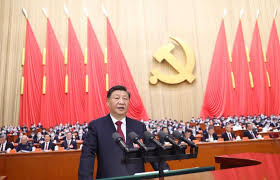Introduction
While much of the global focus has been on Donald Trump’s renewed trade war with China, the deeper test of Xi Jinping’s leadership lies not in external tariffs but in mounting domestic economic challenges. With slowing growth, a collapsing housing sector, rising unemployment, and a shrinking workforce, China’s internal pressures are far more pressing than the US tariffs dominating headlines.

1. The Trade War Is a Distraction from Real Pain
Despite the noise around Trump’s 145% tariffs, Chinese traders have responded with satire rather than panic. Viral videos mocking American figures underscore China’s outward defiance. President Xi has echoed a defiant tone, citing China’s history of self-reliance. However, the real economic fault lines are within China’s borders—where slowing domestic demand and social instability threaten long-term growth.
2. A Housing Market in Crisis
China’s once-booming real estate market has become a source of mass disillusionment. Ghost cities filled with empty apartments dot the landscape, and the collapse of home values has gutted consumer confidence. Developers oversupplied the market, and by some estimates, China now has enough vacant housing for 3 billion people. Efforts to curb debt came too late, and house prices are projected to decline further in 2025.
3. Shrinking Consumer Confidence
Middle-class Chinese families are hesitant to spend amid economic uncertainty. Confidence has been further dented by concerns over pensions and future financial security. With 300 million people set to retire in the next decade, a 2019 report projected that China’s pension fund may be depleted by 2035.
4. Soaring Youth Unemployment
China’s younger generation faces a bleak job market. Official data from August 2023 revealed that over 20% of urban youth aged 16-24 were unemployed. The government has since stopped publishing such figures, but the problem persists, fueling public dissatisfaction and sparking localized protests despite state censorship.
5. Domestic Demand Cannot Replace Exports—Yet
Experts like Prof. Nie Huihua of Renmin University argue that internal consumption cannot immediately replace US-bound exports. Efforts like $41 billion in consumption subsidies and family-friendly policies aim to stimulate spending, but experts warn these are not sustainable without systemic reforms to increase disposable income.
6. Technology and Manufacturing Strengths Offer Hope
China has made notable strides in advanced industries such as consumer electronics, AI, EVs, and batteries. Companies like BYD have outpaced Tesla in global EV sales, and homegrown innovations like DeepSeek challenge US tech dominance. Still, US sanctions on semiconductor exports and restrictions on firms like Nvidia threaten these gains.
7. Global Diversification and the Belt and Road Strategy
As the US clamps down, China has deepened its trade relations with Southeast Asia, Africa, and Latin America. Now, over 145 countries trade more with China than with the US. Initiatives like the Belt and Road have helped Beijing weather the trade storm by tapping new markets and supply chains, such as manufacturing hubs in Vietnam and Cambodia.
Even with all the various difficulties, Xi is betting that Beijing will be able to withstand any economic pain longer than Washington in this great power competition.
And it does appear that Trump has blinked first, last week hinting at a potential U-turn on tariffs, saying that the taxes he has so far imposed on Chinese imports would “come down substantially, but it won’t be zero”.
Meanwhile, Chinese social media is back in action.
“Trump has chickened out,” was one of the top trending search topics on the Chinese social media platform Weibo after the US president softened his approach to tariffs.
Even if or when talks do happen, China is playing a longer game.
The last trade war forced it to diversify its export market away from the US towards other markets – especially in the Global South.
This trade war has China looking in the mirror to see its own flaws – and whether it can fix them will be up to policies made in Beijing, not Washington.
Conclusion
Xi Jinping’s true challenge lies in resolving China’s domestic economic vulnerabilities. While Trump’s tariffs may dominate the headlines, it’s the structural issues—collapsing real estate, job scarcity, and demographic pressure—that will define the success or failure of Xi’s vision. China must not only survive this trade war, but use it as an impetus for long-overdue internal reform. Whether Xi can turn this crisis into opportunity depends on decisions made in Beijing—not Washington.
Related Reading: Impact of BYD Surpassing Tesla in EV Race
Sources: BBC, Reuters, Freedom House, Chinese Academy of Social Sciences









